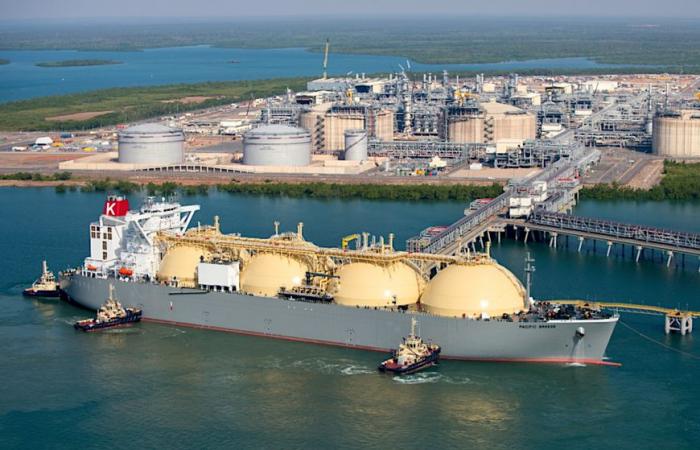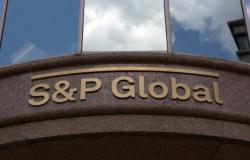Despite a risk of escalation in the Middle East, European oil companies recorded a third quarter at levels close to the Covid era when oil was superfluous in a world under lockdown. The gas activity of Shell and TotalEnergies partly compensated. However, maritime transport of LNG is sluggish. And the largely underutilized LNG terminals.
Gone are the days when the oil majors prospered on the surge in gas and oil prices in the wake of the Russian invasion of Ukraine. The risk of escalation in the Middle East will not have had the same effect even if it caused a rebound at the end of the third quarter. On the other hand, we are not that far removed from the “Covidian” era when oil companies were drilling deep in a closed world for which oil seemed so superfluous.
TotalEnergies recorded the biggest drop in profits since the pandemic in the third quarter. Although at $2.3 billion, net profit fell by 65%, to a level close to the fourth quarter of 2020 when Covid had brought the barrel of Brent to the bottom and caused a contango situation. Adjusted net profit stood at $4.1 billion over the period. And over the first nine months of the year, it will have fallen by 28% (year-on-year), to $11.8 billion.
The world's fourth largest oil and gas company is not the only one to experience this regime. All European majors are affected by the fall in oil prices and the deterioration of refining margins. Production remains too high in the face of sluggish global demand, hampered by the shaky economic health of the world's largest customer, China.
All on the same diet
Shell, which shares with TotalEnergies the fact of having reaped the highest annual profit in their history in 2022, at $42.3 and $20.5 billion respectively, published a net result of $4.3 billion on October 31. (income attributable to shareholders), compared to 7 billion in the same period last year, and an adjusted profit of $6.03 billion (versus $6.22 billion last year). The other major in the sector, BP, declared, two days before the Anglo-Dutch company, a profit breaking into the billions ($206 million) compared to 4.9 billion a year earlier.
On October 31, the price of a barrel of Brent from the North Sea, for delivery in December, was trading at $72.62.
Picked up by LNG
On the other hand, for Shell and TotalEnergies, the oil difficulties were partly offset by the increase in volumes of gas activity, driven by the sustained prices of European gas in a context of anticipation of winter consumption. Shell sold 17 Mt of LNG in the third quarter, 600,000 t more than the previous quarter, and liquefied 7.5 Mt (6.9 Mt in the second quarter).
For the French company, the world's second largest LNG operator in the private sector behind Shell, sales of liquefied natural gas are also up 8% from one quarter to the next (10.5 Mt in the third quarter and 29 Mt over nine months). ), supported by the increase in spot volumes and the approach of cold weather. Hydrocarbon production for LNG is, however, down 7% compared to the second quarter, linked to unplanned maintenance on the Ichthys LNG liquefaction plant (8.9 Mt per year), northwest of Australia. The French group is banking on the firmness of gas prices in Europe, which it anticipates around $10/Mbtu in the fourth quarter.
TotalEnergies has been organizing itself for several years to meet the demand for the fleet of LNG-powered ships, estimated at this stage at 1,000 in operation or on order. On October 10, the French signed a charter contract with the shipowner Ibaizabal for an additional LNG bunker with a capacity of 18,600 m3which is expected to enter service in 2026 to serve the Oman Basin. This is the fourth in its fleet after the Gas Agility based in Rotterdam, the Gas Vitality in Marseille-Fos, and the Brassavola in Singapore.
LNG carriers below the break-even point?
However, LNG shipping is not in the best shape, with many LNG tankers operating below the break-even point on spot markets.
LNG carrier charter rates are likely to be well below 2022-2023 peaks this year, being subject to oblique winds, starting with unfavorable supply and demand fundamentals: outstanding orders represent 50%. of the fleet in operation and 66 LNG carriers and 94 are expected to be delivered this year and in 2025 respectively, according to Drewry. Geopolitical risks, transit difficulties through the Suez and Panama canals, the American presidential elections, sanctions against Russian LNG and gas demand in Europe should also weigh.
Currently, according to Jefferies statements, two-stroke charter rates for LNG carriers are valued at $31,000 per day. The analyst estimates LNG shipping capacity utilization at 84% for 2024, with a 4% increase due to Red Sea diversions, compared to 86% in 2023, and 81% anticipated in 2025. Under these conditions, charterers have taken a step back from the futures markets and little activity has been reported recently for medium and long term charters. “, he notes.
« The weakness of European demand, due to the abundance of stocks [94 % au 4 octobre, NDLR], the increase in renewable and nuclear production, and the lack of revival of industrial growth “, does not help the market, indicates Drewry for his part.
Oversized LNG import capacities in Europe?
In Europe, market conditions seem harsher. According to the Institute for Energy Economics and Financial Analysis (IEEFA), which specializes in energy markets, gas consumption in Europe fell by 5.4% year-on-year during the first half of the year, its lowest point in 10 years in 2023. The company also notes a slowdown in imports, of 20% in Europe and 11% in the EU. The data serves the argument of the company which has already published several notes on the under-exploitation of LNG import terminals in the European Union. The average utilization rate fell from 62.8% to 47.2 % between the first and second half of 2024 according to its European LNG Tracker monitoring tool.
While Europe increased its import capacity by 23%, or 58 billion m3 since 2022 (including 6.5 billion m3 in France) following Russia's invasion of Ukraine in 2022 and the subsequent interruption of gas supplies via a Russian pipeline, Europe's LNG terminal construction frenzy could be coming to an end, he believes. « Some countries are delaying or canceling infrastructure. Since the start of 2023, new terminals or expansions have been suspended in Albania, Cyprus, Ireland, Latvia, Lithuania and Poland. It is unclear whether the three planned terminals in Greece will be built “, says Ana Maria Jaller-Makarewicz, chief energy analyst at IEEFA. One of them, carried by the Greek operator Gastrade, has in any case just entered service in the north-east of Greece, at the port of Alexandroupolis. Supplied with gas from the United States, Qatar and Egypt, it is intended to serve central Europe.
On the other hand, entries of Russian LNG into Europe still increased by 11% in the first half of 2024 year-on-year. And this, despite the EU's objective of no longer depending on Russian fossil fuels by 2027. In June, Brussels decided to ban the transshipment of Russian LNG in its ports from March 2025. The rest of the story remains to be written.
Adeline Descamps






